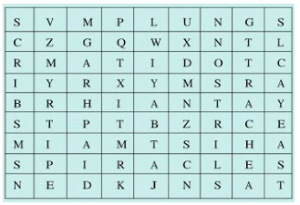NCERT Solutions for class 7 Science Chapter-10 Respiration in Organisms
Q.1 Why does an athlete breathe faster and deeper than usual after finishing the race?
Ans.1– The athlete needs a lot of energy during the race and for the release of energy ,they need a lot of Oxygen ;hence they breathe faster and more profound that usual after finishing the race.
Q.2– List the similarities and differences between aerobic and anaerobic respiration.
Ans.2– Similarities:-
- In Both Respiration and food is broken down to release energy.
Differences:-
| Aerobic Respiration | Anaerobic Respiration | |
| 1. | Takes Place in presence of O2 | Takes place in absence of O2 |
| 2. | It is slow process | It is fast process |
| 3. | Energy is release in much amount | Energy is release in least amount |
| 4. | Ex. Animals and Plants etc. | Ex. Bacteria and human cells etc. |
Q.3– Why do we often sneeze when we inhale a lot of dust – laden air?
Ans.3– When we inhale lot of dust – laden air and these particles get pass the hair in nose and nasal cavity and irritate of the cavity which results are sneeze.
Q.4– Take three test-tubes. Fill each of them with water. Label them A, B and C. Keep a snail in test-tube A, a water plant in test-tube B and in C, keep snail and plant both. Which test-tube would have the highest concentration of CO2?
Ans.4– In Test tube – C have the highest concentration.
Q.5– Tick the correct answer:-
- In cockroaches, air enters the body through
- Lungs
- Gills
- Spiracles
- Skin
Ans. a– iii. Spiracles
- During heavy exercise, we get cramps in the legs due to the accumulation of
- Carbon dioxide
- Lactic acid
- Alcohol
- Water
Ans. b– ii. Lactic acid.
- Normal range of breathing rate per minute in an average adult person at rest is:
- 9 – 12
- 15 – 18
- 21 – 24
- 30 – 33
Ans. c– ii. 15 – 18.
- During exhalation, the ribs
- Move outwards
- Move downwards
- Move upward
- Do not move at all
Ans. d– ii. Move downward.
Q.6– Match the items in Column I with those in Column II:
| Column I | Column II |
| a. Yeast | i. Earthworm |
| b. Diaphragm | ii. Gills |
| c. Skin | iii. Alcohol |
| d. Leaves | iv. Chest cavity |
| e. Fish | v. Stomata |
| f. Frog | vi. Lungs and skin |
| vii. Trachea |
Ans.6–
| Column I | Column II |
| a. Yeast | iii. Alcohol |
| b. Diaphragm | iv. Chest Cavity |
| c. Skin | i. Earthworm |
| d. Leaves | v. Stomata |
| e. Fish | ii. Gills |
| f. Frog | vi. Lungs and skin |
Q.7– Mark ‘T’ if the statement is true and ‘F’ if it is false:
- During heavy exercise the breathing rate of a person slows down. (T/F)
- Plants carry out photosynthesis only during the day and respiration only at night. (T/F)
- Frogs breathe through their skins as well as their lungs. (T/F)
- The fishes have lungs for respiration. (T/F)
- The size of the chest cavity increases during inhalation. (T/F)
Ans.7–
- False
- False
- True
- False
- True
Q.8– Given below is a square of letters in which are hidden different words related to respiration in organisms. These words may be present in any direction – upwards, downwards, or along the diagonals. Find the words for your respiratory system. Clues about those words are given below the square.
- The air tubes of insect.
- Skeletal structure surround chest cavity.
- Muscular floor of chest cavity.
- Tiny pores on the surface of leaf
- Small openings on the sides of the body of an insect.
- The respiratory organs of human beings.
- The opening though which we inhale.
- An anaerobic organism.
- An organism with tracheal system.

Ans.8–
- Trachea
- Ribs
- Diaphragm
- Stomata
- Spiracles
- Lungs
- Nostrils
- Yeast
- Ant
(Student self search in word box)
Q.9– The mountaineers carry oxygen with them because:
- At an altitude of more than 5 km there is no air.
- The amount of air available to a person is less than that available on the ground.
- The temperature of air is higher than that on the ground.
- The pressure of air is higher than that on the ground.
Ans.9– b. The amount of air available to a person is less than that available on the ground.
NCERT Solutions for class 7 English Poem